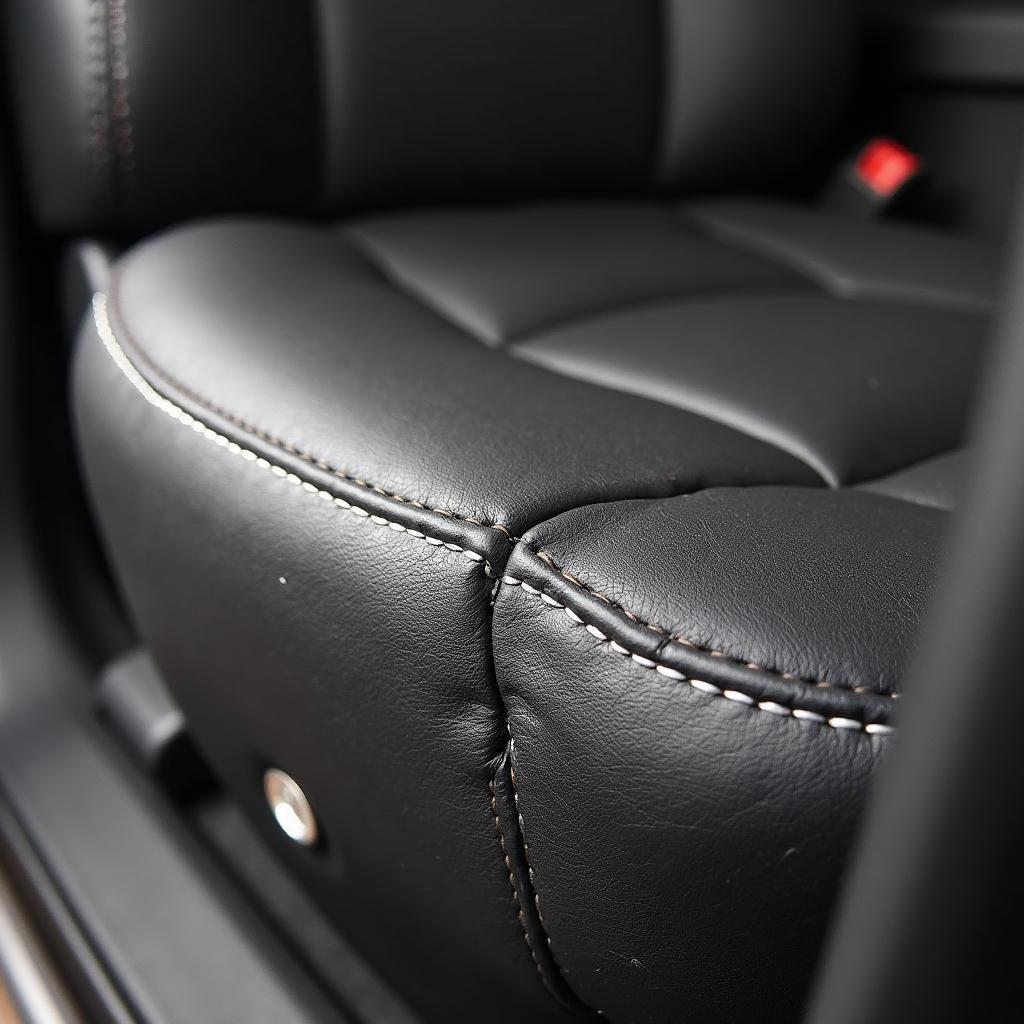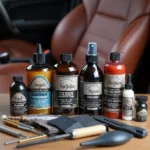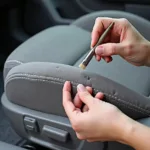Discovering a hole in your car seat can be disheartening, especially if you take pride in a well-maintained vehicle. But don’t worry, a little DIY spirit and the right approach can have your car seats looking their best again. This guide will provide comprehensive steps and expert advice to help you repair those pesky holes and restore your car’s interior.
Assessing the Damage: The First Step to Repairing Holes in Car Seats
Before diving into the repair process, it’s crucial to evaluate the extent of the damage. The size, location, and type of hole will determine the most effective repair method.
- Small Holes and Tears: These are often caused by sharp objects or accidental snags and are relatively easy to fix using a patching technique and adhesive.
- Burn Holes: Cigarettes are often the culprit here. Repairing burn holes often involves patching, filling, and color matching for a seamless look.
- Large Tears or Rips: These usually require more extensive repairs, and depending on the severity, might even need professional intervention.
Gathering Your Supplies: Essential Tools for Car Seat Repair
Having the right tools and materials on hand makes the repair process smoother and more successful. Here’s a list of items you’ll likely need:
- Cleaning Supplies: A gentle cleaner, microfiber cloths, rubbing alcohol (for leather)
- Repair Patch: Leather or vinyl patch, depending on your car seat material
- Adhesive: Leather adhesive, fabric glue, or a hot glue gun
- Scissors
- Colorant or Dye: (If needed) Leather dye or fabric paint that matches your car seat color
- Applicator Tools: Sponges, cotton swabs, or a small brush for applying dye
- Heat Gun or Hair Dryer: (Optional) Useful for setting adhesives and dyes
How to Repair Holes in Car Seats: Step-by-Step Guide
Now that you have a good understanding of the damage and have your supplies ready, let’s get to the actual repair.
Step 1: Clean the Area
Thoroughly clean the area around the hole using a gentle cleaner and a microfiber cloth. For leather seats, use a leather cleaner followed by rubbing alcohol to remove any residues. Allow the area to dry completely.
Step 2: Prepare the Patch
- If you’re using a pre-made patch, ensure it’s slightly larger than the hole.
- If you need to cut a patch from a larger piece of material, make sure it matches the texture and color of your car seat as closely as possible.
Step 3: Apply the Adhesive
Apply a thin layer of adhesive to the back of the patch, ensuring even coverage. For deeper holes, you might need to fill the cavity slightly with a filler material before applying the patch.
Step 4: Place the Patch
Carefully align the patch over the hole and press it firmly into place. Use your fingers to smooth out any wrinkles or bubbles.
Step 5: Drying and Setting
Allow the adhesive to dry completely according to the manufacturer’s instructions. You can use a heat gun or a hairdryer on a low setting to speed up the drying process.
Step 6: Color Matching (If Needed)
For noticeable repairs, you might need to use a colorant or dye to blend the patch with the surrounding material. Apply the dye sparingly in thin layers, allowing each layer to dry completely before applying the next.
How to Repair Burn Holes in Car Seats: A Specialized Approach
Burn holes require a slightly different approach as they often involve damage to both the surface material and the underlying padding.
- Filling the Hole: Use a specialized burn hole filler or a high-heat epoxy to fill the hole and create an even surface.
- Color Matching: Carefully match the color of the filler to your car seat using a dye or paint specifically designed for automotive upholstery.
Professional vs. DIY Car Seat Repair: When to Call the Experts
While many car seat repairs can be tackled successfully at home, there are instances where professional help might be necessary. Consider these factors:
- Extensive Damage: Large tears, deep cuts, or damage to the seat’s structural integrity often require professional expertise and specialized tools.
- High-Value Vehicles: If you own a luxury car or a vehicle with delicate upholstery, it’s best to entrust the repair to professionals to avoid further damage or depreciation.
- Lack of Confidence: If you’re unsure about your DIY skills or uncomfortable working with adhesives and dyes, seeking professional help is a wise choice.
Preventing Future Damage: Tips for Maintaining Your Car Seats
Prevention is always better than cure. Here are a few tips to keep your car seats in top condition and avoid those unwanted holes:
- Regular Cleaning: Frequent cleaning prevents dirt and grime from becoming embedded in the material, reducing wear and tear.
- Protective Covers: Consider using seat covers, especially if you frequently transport children or pets.
- Careful Entry and Exit: Avoid sliding in and out of your car while wearing sharp objects like keys or tools.
- Promptly Address Spills: Clean up any spills immediately to prevent staining and damage to the upholstery.
By following these simple tips, you can prolong the life of your car seats and keep your car’s interior looking its best for years to come.
FAQs about How to Repair Holes in Car Seats
Q: Can I use super glue to repair a hole in my car seat?
A: While super glue might seem like a quick fix, it’s not recommended for car seat repairs. Super glue can dry stiff, making the repair prone to cracking, and it doesn’t bond well with porous materials like fabric.
Q: How do you repair burn holes in fabric car seats?
A: Repairing burn holes in fabric car seats often involves patching the hole with a matching fabric piece using fabric glue. For best results, you can refer to our detailed guide on how to repair burn holes in fabric car seats.
Q: Can a ripped leather car seat be repaired?
A: Yes, a ripped leather car seat can often be repaired, depending on the severity of the rip. For small tears, a leather repair kit can be effective. Larger tears might require professional car leather seat repair services.
Q: How much does it cost to fix a tear in a leather car seat?
A: The cost of fixing a tear in a leather car seat can vary depending on the size and location of the tear and whether you opt for a DIY repair or hire a professional. For more information on car seat repair costs, check out our detailed guide on how to repair a leather tear in a car seat.
Q: How do you repair burn holes in car seats caused by cigarettes?
A: Cigarette burns are a common cause of car seat damage. Our comprehensive guide on how to repair burn holes in car seats provides step-by-step instructions on effectively addressing these types of repairs.
Need More Help? We’re Here for You!
Repairing holes in car seats can be a rewarding DIY project, restoring your car’s interior and boosting your sense of accomplishment. But we understand that sometimes you might need a helping hand. If you have any questions or need further assistance with your car repair needs, don’t hesitate to reach out. Our expert team is available 24/7 to provide guidance and support. You can contact us via WhatsApp at +1(641)206-8880 or email us at [email protected]. We’re always happy to help you get back on the road with confidence!



